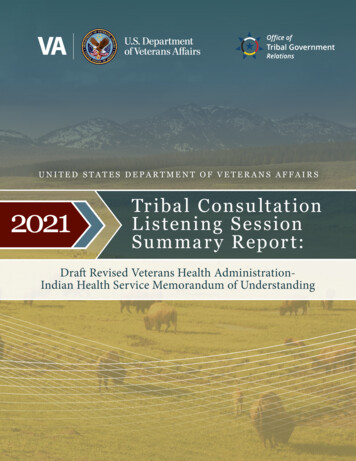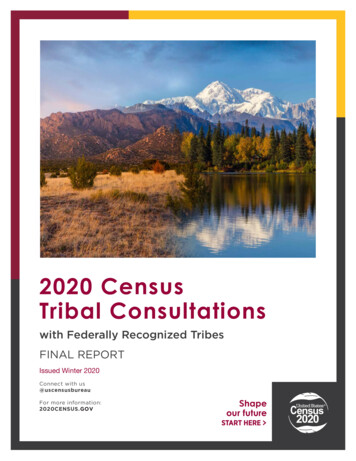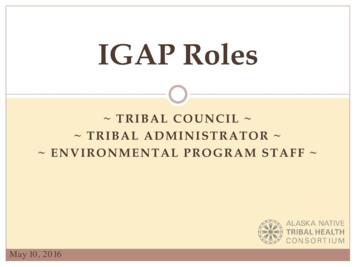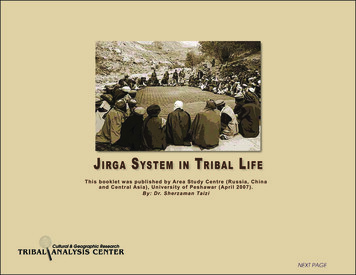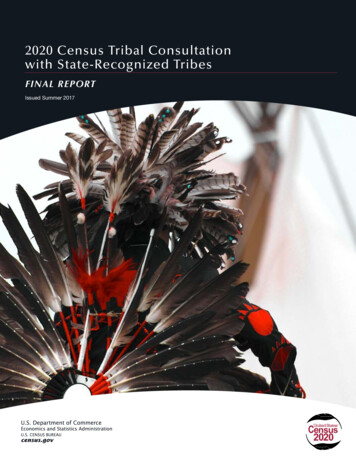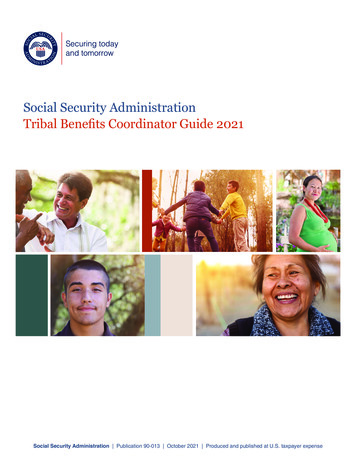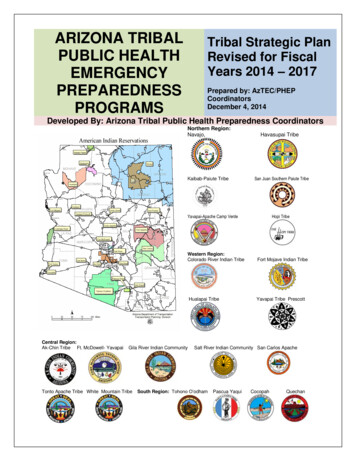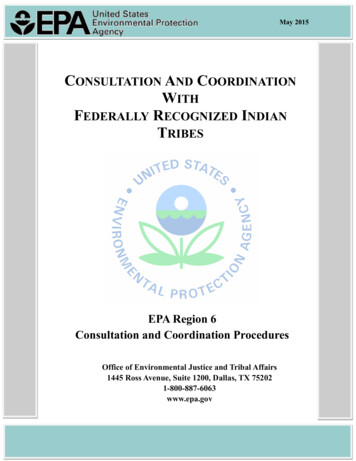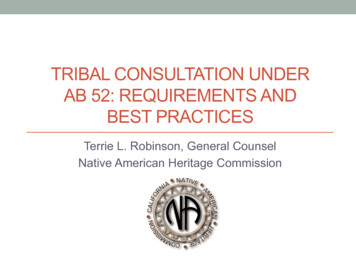
Transcription
TRIBAL CONSULTATION UNDERAB 52: REQUIREMENTS ANDBEST PRACTICESTerrie L. Robinson, General CounselNative American Heritage Commission
2Presentation Outline Goals of Tribal Consultation (AB 52 or Otherwise) forPlanning AB 52 Tribal Consultation Procedural Requirements AB 52 Tribal Consultation Substantive Requirements NAHC’s Proposed AB 52 Tribal Consultation BestPractices Five Most Important Things Agencies Should Know AboutAB 52
3Goals of Tribal Consultation (AB 52 orOtherwise) for Planning Get needed information in order to preserve the options ofavoidance of cultural resources or preservation in place early in theplanning process. Build working relationships with tribes that are traditionally andculturally affiliated to the project area or to your agency’sgeographic area of jurisdiction. Avoid inadvertent discoveries of Native American burials and workwith tribes in advance to determine treatment and disposition ifburials are inadvertently discovered. Statutory and CEQA Guidelines procedures for inadvertent discoveriesof Native American burials differ from CEQA tribal consultation regardingimpacts to cultural resources– only option upon impasse with a tribe isto reinter the remains on the property in an area without furthersubsurface disturbance.
4AB 52 Tribal Consultation ProceduralRequirements Prerequisites for AB 52 Tribal Consultation Applies to any project for which a Notice of Preparation, Notice ofMitigated Negative Declaration or Notice of Negative Declaration isfiled on or after July 1, 2015. A tribe that is traditionally and culturally affiliated to the geographicarea where a project is located must have requested that the leadagency in question provide notification to the tribe of projects in thetribe’s area of traditional and cultural affiliation.
5AB 52 Tribal Consultation ProceduralRequirements Timeline and Notice Requirements: Five Steps Step One: Tribe Requests Notification In order to participate in AB 52 tribal consultation, a tribe must request,in writing, to be notified by lead agencies through formal notification ofproposed projects in the geographic area with which the tribe istraditionally and culturally affiliated. Without this request, there is no requirement that a lead agency engagein AB 52 tribal consultation. Failure to request notification does not preclude non-AB 52 tribalconsultation (more on this later).
6AB 52 Tribal Consultation ProceduralRequirements -- Timeline and Notice Step Two: Notification by Lead Agency Within 14 days of determining that an application for a project iscomplete or of a decision by a public agency to undertake aproject, a lead agency must provide formal notification to thedesignated contact or tribal representative of traditionally andculturally affiliated California Native American tribes that haverequested notice (Step One).
7AB 52 Tribal Consultation ProceduralRequirements -- Timeline and Notice Step Two (cont’d): This notice shall be accomplished byat least one written notification that includes: A brief description of the proposed project; The project’s location; The lead agency contact information; and Notification that the tribe HAS 30 DAYS TO REQUESTCONSULTATION.
8AB 52 Tribal Consultation ProceduralRequirements – Timeline and Notice Step Three: Tribe Requests Consultation The tribe must respond, in writing, within 30 days of receipt of theformal notification and request consultation. When responding to the lead agency, the tribe shall designate alead contact person. If the tribe does not designate a lead contact person or designatesmultiple lead contact persons, the lead agency shall defer to theperson listed on the contact list maintained by the NAHC for SB 18consultation.
9AB 52 Tribal Consultation ProceduralRequirements – Timeline and Notice Step Four: Lead Agency Begins Consultation The lead agency shall begin the consultation process within 30days of receiving a California Native American tribe’s request forconsultation and prior to the release of a negative declaration,mitigated negative declaration, or environmental impact report. For purposes of AB 52, “consultation” shall have the same meaningas provided in SB 18 (Govt. Code Section 65352.4).
10AB 52 Tribal Consultation ProceduralRequirements – Timeline and Notice Step Five: Conclusion of Consultation Consultation is concluded when either of the following occurs: The parties agree to measures to mitigate or avoid a significant effect, ifa significant effect exists to a tribal cultural resource; or A party, acting in good faith and after reasonable effort, concludes thatmutual agreement cannot be reached.
11AB 52 Tribal Consultation ProceduralRequirements -- Confidentiality AB 52 requires that any information – not just documents– submitted by a California Native American tribe duringthe environmental review process shall not be included inthe environmental review document or otherwisedisclosed consistent with Govt. Code Sections 6254(r)and 6254.10.
12AB 52 Tribal Consultation ProceduralRequirements -- Confidentiality Unless the tribe agrees in writing, the project applicant orthe project applicant’s legal advisors, using a reasonabledegree of care, shall maintain the confidentiality of theinformation exchanged for the purposes of preventinglooting, vandalism or damage to a tribal cultural resourceand shall not disclose the information to a third party.
13AB 52 Tribal Consultation ProceduralRequirements -- Confidentiality CEQA Guidelines Section 15120 (d) states that nodocument prepared for public examination shall includeinformation about the location of sacred sites – doesn’tprotect the information from other forms of publicdisclosure.
14AB 52 Tribal Consultation ProceduralRequirements -- Confidentiality AB 52’s confidentiality provisions DO NOT APPLY TODATA OR INFORMATION THAT IS: Already publicly available. Already in the lawful possession of the project applicant before itwas provided by the tribe. Independently developed by the project applicant or the projectapplicant’s agents. Lawfully obtained by a third party.
15AB 52 Tribal Consultation ProceduralRequirements – Compared to SB 18’s Who the law applies to: SB18: All California tribes, and local governments that adopt or amendgeneral plans or specific plans or create open space designations. AB 52: All California tribes and all CEQA lead agencies. What the law applies to: SB18: Adoption or amendment of general plans or specific plans oropen space designations. AB 52: All CEQA projects for which an NOP, Notice of MitigatedNegative Declaration or Notice of Negative Declaration is filed orissued after July 1, 2015.
16AB 52 Tribal Consultation ProceduralRequirements – Compared to SB 18’s What triggers the law: SB 18: Amendment or adoption of a general plan or a specific planor designation of open space. A local government sends proposalinformation to the NAHC and requests contact information for tribeswith traditional lands or places located in geographic area affectedby proposed changes. AB 52: Letters from tribes requesting notification by lead agency ofprojects in their areas of traditional or cultural affiliation.
17AB 52 Tribal Consultation ProceduralRequirements – Compared to SB 18’s How does tribal consultation begin and when? SB 18: Local government contacts tribes about opportunity to consult. Tribes have 90 days to request consultation. AB 52 Lead agency contacts tribes that have requested notification of projects within 14 daysof an application being complete or the lead agency’s decision to undertake a project. Tribes have 30 days to request consultation. How long does tribal consultation last? SB 18: No statutory limit. AB 52: No statutory limit, but the environmental documents cannot be released untilconsultation has been initiated. Environmental documents cannot be certified untilconsultation, if initiated, has concluded.
18AB 52 Tribal Consultation ProceduralRequirements – Compared to SB 18’s How does consultation end? SB 18 and AB 52: Consultation is concluded when: Parties reach mutual agreement concerning appropriate measures forpreservation or mitigation; or Either party, acting in good faith or after reasonable effort, concludesthat mutual agreement cannot be reached concerning appropriatemeasures of preservation or mitigation.
19AB 52 Tribal Consultation SubstantiveRequirements Mandatory Topics of Consultation (If requested by tribe): Alternatives to the project. Recommended mitigation measures. Significant effects. Discretionary Topics of Consultation: The type of environmental review necessary. The significance of tribal cultural resources. The significance of the project’s impacts on the tribal cultural resources; and If necessary, project alternatives or appropriate measures for preservation ormitigation that the tribe may recommend.
20AB 52 Tribal Consultation SubstantiveRequirements An EIR, MND or ND cannot be certified unless one of thefollowing occurs: The consultation process between the tribe and the lead agencyhas concluded; The tribe requested consultation but failed to provide comments orotherwise failed to engage in consultation; The lead agency provided notice of the project a tribes and thetribe failed to request consultation within the 30 day deadline.
21AB 52 Tribal Consultation SubstantiveRequirements If mitigation measures agreed upon and recommended bystaff are not included in the environmental document or ifthere are no agreed upon mitigation measures, the leadagency shall consider feasible mitigation measurespursuant to subdivision (b) of Section 20184.3.
22AB 52 Tribal Consultation Best Practices Goals of AB 52 Tribal Consultation Should Be: To discuss mandatory and discretionary topics requested by tribe,particularly significance of tribal cultural resources, avoidance,preservation in place, and/or mitigation measures; To achieve resolution on those topics; and If resolution is not possible, to document why and what efforts weremade. What AB 52 Tribal Consultation Should Not Be: An information exchange in order to discuss mandatory anddiscretionary topics – information needed to conduct AB 52 tribalconsultation should be gathered in advance. Remember – EIR, MND or ND cannot be certified until tribalconsultation, if requested and engaged in, is completed.
23AB 52 Tribal Consultation Best Practices Before you begin: Understand that tribes expect to be respectfully engaged and expecttheir proposals to be thoughtfully considered, even if not expressed intechnical language. Understand that the discussion of confidential sacred site locations,burial locations, and tribal practices touches on spiritual matters andwould not occur but for the possibility of protecting the tribe’s culturalresources; think of how you would want your spiritual beliefs andpractices respected and act accordingly. Understand that tribes don’t want to be persuaded to accept yourpreconceived plans; they want to be involved in the planning. Under no circumstances should you issue an ultimatum to a tribe.Tribal consultation is not an “accommodation” to a tribe; it’s the law.
24AB 52 Tribal Consultation Best Practices Do your research before the determination to undertake a projector before an application is complete. Request Sacred Lands Inventory and CHRIS searches to find out thecultural resources in your proposed project area. Request an AB 52 list of culturally affiliated tribes -- research: Current tribal leadership (The Governor’s Office of the Tribal Advisor haspublished a California Tribal Directory) Area of traditional and cultural affiliation Newspaper articles and other indicia of tribes’ concerns about your project Other projects about which your agency has consulted the tribe and how theconsultation process went
25AB 52 Tribal Consultation Best Practices Do your research (cont’d): Review ethnographic studies to determine possible village sites, sacredsites and/or burials not indicated on the Sacred Land Inventory orCHRIS. Document confidential tribal cultural resource information alreadypossessed by the lead agency, applicant and applicant’s counsel. Review previous geotechnical and archaeological reports, as well asany relevant prior environmental documents for the project site. Consult with culturally affiliated tribes about cultural resources inadvance of AB 52 tribal consultation to find out what cultural resourcesmay be affected by your project. Make sure tribes understand that this isNOT AB 52 consultation.
26AB 52 Tribal Consultation Best Practices Before sending formal notification of projects: Review the SB 18 Consultation Guidelines on the OPR website. Double check within your agency and with consultants to be sureyou have all of the requests for notification received from tribes. Since avoidance of damaging effects to tribal cultural resources, iffeasible, is required, be prepared to consider avoidance or explainwhy it isn’t feasible. Be prepared to consider preservation in placeor explain why it isn’t feasible. Be prepared to discuss all mandatory and discretionary topics ofconsultation. Get all the necessary information needed to do so toavoid using AB 52 consultations as information exchanges.
27AB 52 Tribal Consultation Best PracticesWhen sending AB 52 tribal consultation notices: Make it clear that the notice is for AB 52 consultation, not any otherkind of consultation Include the statutorily required information in your notice: Briefproject description, project’s location, lead agency contactinformation, notice that tribe has 30 days to request consultation. Send your notice return receipt requested to document when it wasreceived.
28AB 52 Tribal Consultation Best Practices When sending consultation notices: Include confidentiality provisions of Public Resources Code section21082.3 (c). Include lead agency’s policy on discretionary determinations ofsignificance of tribal cultural resources. Send more than one consultation notice. Ask responding tribes to be specific as to which mandatory anddiscretionary topics they want to discuss and incorporate thosetopics in your consultation agenda. Seek the tribe’s agreement upon the consultation agenda inadvance of beginning consultation.
29AB 52 Tribal Consultation Best Practices Consultation Keep consultation government-to-government. Tribal representatives shouldbe members of the tribal government or representatives with writtendesignation to speak on behalf of the tribe. Know who will be representing the tribe and follow protocol for meeting withgovernment officials, i.e., know their titles and use them, introduce allparticipants, explain who they represent and why they are present. Agree onone person to lead the meeting and keep the agenda on track. Respect tribal sovereignty and confidentiality. Consult with one tribe at at timeunless tribes agree otherwise, and do so in a private place with only thenecessary participants present. Do not share one tribe’s confidential information with another. Be able toexplain why those who are present need to know confidential information.
30AB 52 Tribal Consultation Best Practices Consultation (cont’d): Document in real time: Consultation topics discussed and resolution, if any. Confidential information received from tribe and the form in which it wasreceived. Whether subsequent consultation sessions will be needed and what topicswill be discussed. Agree on the next consultation agenda and what additional information, ifany, is needed before the next consultation session. Conclusion of Consultation If agreement was reached on mitigation measures, inform tribe that themitigation measures will be recommended for inclusion in theenvironmental document, but that doesn’t mean they will be included. Document all areas on which agreement was reached or not reached. If consultation is unilaterally concluded, be able to document thatrequirements for doing so have been met.
31AB 52 Tribal Consultation Best Practices After Consultation Review with lead agency staff, consultants and consulting tribeswhat worked, what didn’t, and how consultation can be improved.
32Five Most Important Things for Agenciesto Know About AB 52 Unless a tribe requests notification of projects in their areaof traditional and cultural affiliation, there is no AB 52consultation obligation with them. Lead agencies have an affirmative duty to use reasonablecare to protect confidential information received fromtribes through consultation, with exceptions. An environmental document cannot be released untilconsultation with tribes that have sent notification andconsultation requests has been initiated.
33Five Most Important Things for Agenciesto Know About AB 52 An EIR, MND or ND cannot be certified, until AB 52 tribalconsultation has concluded. If mitigation measures are agreed upon with a tribe, themeasures must be recommended for inclusion in theenvironmental document.
34Thank You! Questions? Contact Terrie Robinson, NAHC General Counsel,terrie.robinson@nahc.ca.gov, (916) 373-3716 Contact Rob Wood, NAHC Analyst and designated “Mr. AB 52,”rob.wood@nahc.ca.gov, (916) 373-3711 Check our website, nahc.ca.gov, for future guidance on AB 52 bestpractices
5 AB 52 Tribal Consultation Procedural Requirements Timeline and Notice Requirements: Five Steps Step One: Tribe Requests Notification In order to participate in AB 52 tribal consultation, a tribe must request, in writing, to be notified by lead agencies through formal notification of proposed projects in the geographic area with which the tribe is
